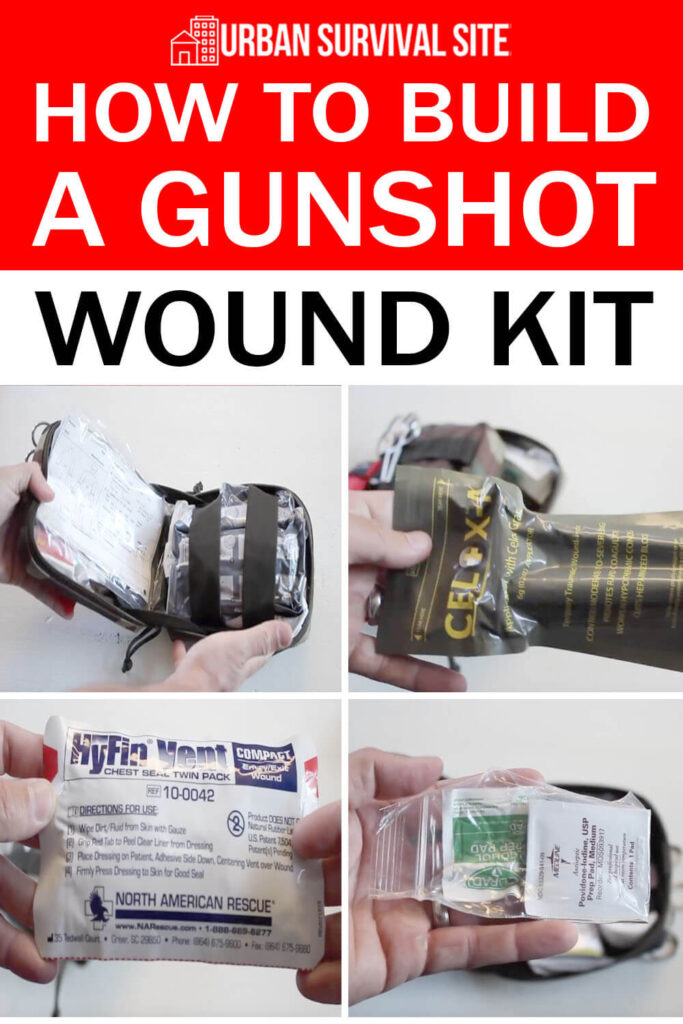How to Build a Gunshot Wound Kit

Estimated reading time: 8 minutes
Gunshot wounds can be unpredictable and life-threatening. They demand immediate attention, especially in high-risk professions like law enforcement or the military. Even in SHTF scenarios, such as natural disasters or civil unrest, being prepared is non-negotiable.
Avoiding these types of injuries is the best medicine, but just in case it’s good to have a gunshot wound kit handy. This article will teach you how to create your gunshot wound kit, possibly a vital tool in these extreme situations.
Article continues below.
Want to save this post for later? Click Here to Pin It On Pinterest!
When dealing with gunshot wounds, it’s important to remember that they are not uniform; their severity can vary greatly depending on several factors.
Damage caused by gunshot wounds extends far beyond the visible injury. The ballistic trauma inflicted can lead to internal bleeding, organ damage, and even death if not addressed immediately.
The high velocity of the bullet causes a shock wave that can damage tissues and organs not directly in the bullet’s path. Even after the bullet is taken out, the remaining wounds carry a high risk of infection, as the bullet can introduce bacteria from the skin into the deeper tissues.
Gunshot wounds can differ greatly based on the caliber and velocity of the bullet, the distance from which the shot was fired, and the part of the body hit.
To give you an example, a wound from a .22 caliber bullet will differ significantly from a wound inflicted by a .45 caliber bullet. This is because a .45 caliber is larger and has more stopping power.
However, that’s not the only factor, wounds to the chest or abdomen can be more life-threatening than those to the limbs, regardless of caliber.
While the 2 basic gun wound types are generally penetrating or perforating, there are others pertaining to different parts of the body. Here is a list of gunshot wound types and the bullets that tend to cause them for reference.
A gunshot wound, regardless of its type, is a critical and potentially life-threatening injury. The immediate response and first aid offered can significantly influence the patient’s survival and recovery. Having a well-equipped gunshot wound kit is pivotal in such situations.
A gunshot wound kit can be quite extensive and some items might have to be acquired through a hospital supply company, but here are the basic items you should have in the kit.
A lot of these items can be found in a standard first aid kit but can also be great when added to your gunshot wound kit. While these are good to have, they are for more general wound treatment and don’t have gun wound-specific uses. As such, these are considered “additional” and not necessarily needed.
Using a gunshot wound kit effectively is all about keeping your cool and knowing where everything is. Organize your kit like a pro – have each item in a specific spot for quick and easy access. It can’t be stressed enough that when a gunshot wound needs to be treated, every second matters.
Understanding how to respond to gunshot wounds is a crucial skill, one that requires more than just a well-stocked kit. While the contents of your gunshot wound kit are vital, they are tools that need a skilled hand to wield effectively.
Some items, like hemostatic agents or tourniquets, require specific expertise to use correctly. Courses such as “Stop the Bleed” provide invaluable knowledge, highlighting the correct techniques and processes to follow.
Not only that, but they empower individuals, giving them the confidence and competence to act decisively in a crisis. When people don’t know what to do in a situation, they tend to freeze. When people freeze, others die.
Being prepared for emergencies, particularly those involving gunshot wounds, is a critical responsibility we all share. A well-organized gunshot wound kit coupled with the necessary training can make a life-changing difference in such critical situations.
These kits are not just assortments of medical supplies but essential tools that, when used skillfully, can save lives. The importance of comprehensive training goes hand in hand with possessing such a kit, enhancing your confidence and effectiveness in crises.
Like this post? Don’t Forget to Pin It On Pinterest!
